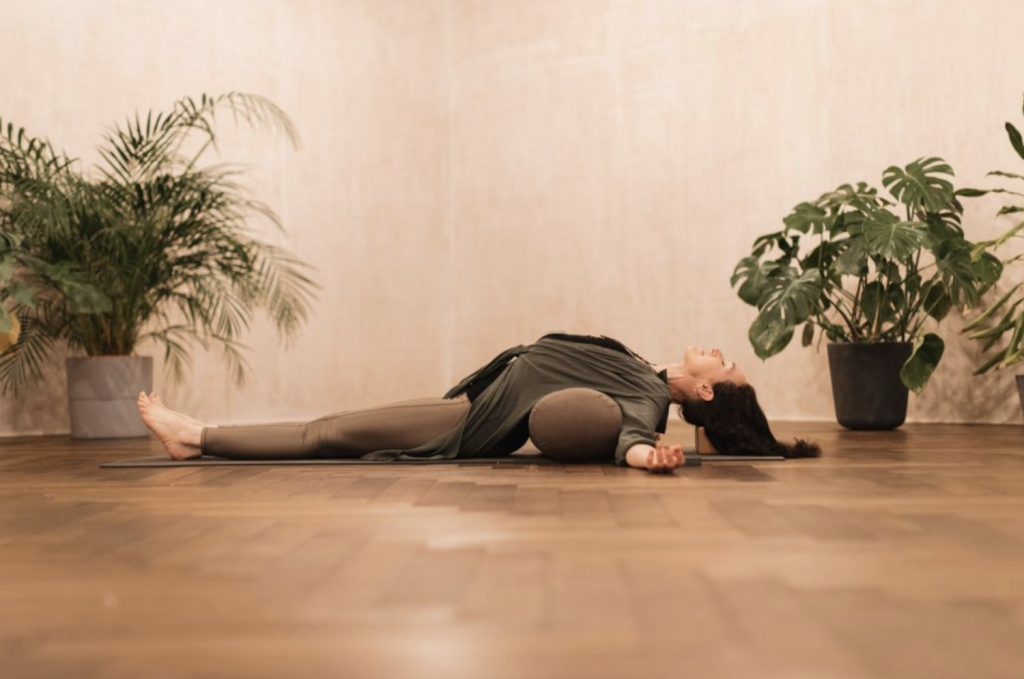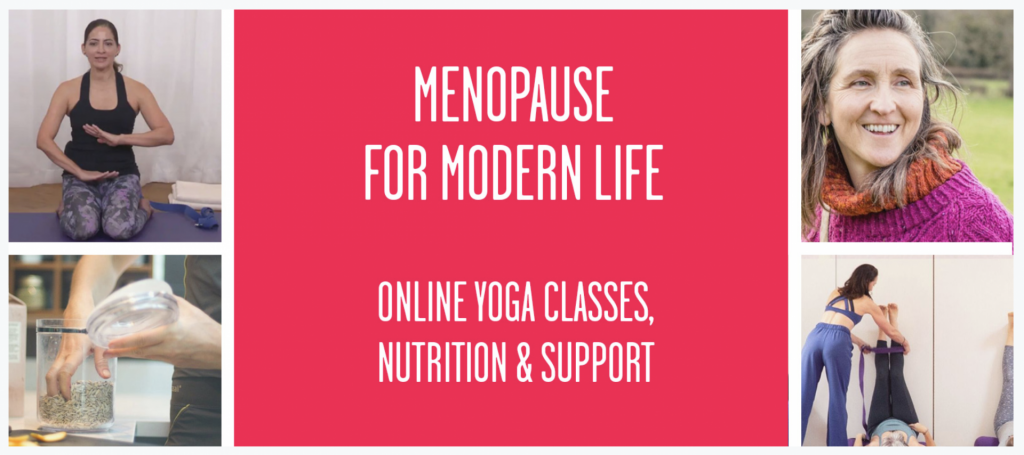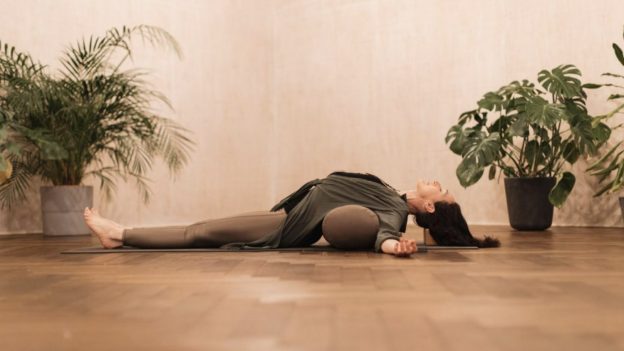
Most of us have probably heard about the menopause, but what about perimenopause? What is it, when does it start? and what can we do to ease the perimenopause journey?
Petra Coveney, founder of Menopause Yoga, shares below about yoga and perimenopause. What is perimenopause? and how yoga can ease our symptoms and support us through this moment of change. (Read more about yoga for menopause in the Movement for Modern Life complete guide).
What is perimenopause?
The menopause is the end of your menstrual cycle and it essentially means that you have completed the reproductive stage of your life. It is time to look forward to your Second Spring, a concept from traditional Chinese medicine of a woman reblooming in post menopause.
But before Menopause comes Perimenopause. This can be a time of turbulence, when fluctuations in your hormones oestrogen, progesterone and testosterone can cause mayhem to your menstrual cycle.
When is perimenopause?
On average, the perimenopause starts in your early to mid-40’s and lasts until menopause, age 50-52 on average, although some women enter at a younger age or complete later. If you have a Mirena coil or other contraception that prevents bleeding, you may not know that you’re in perimenopause – until the symptoms arise.
Read more about yoga for stress and anxiety in this complete guide
Hormonal changes and symptoms of Perimenopause
Hormones are chemicals that send messages to every cell, so the symptoms of perimenopause can affect every part of your body, brain and your emotions. It’s not just hot flushes or menorage! Our symptoms that may be experienced are:
- Anxiety & Overwhelm
- Brain fog
- Insomnia
- Headaches
- Heart palpitations
- Problems with digestion or elimination
- Skin conditions

There could be many more, or equally very few symptoms. This is because everyone’s experience is unique. This may partly be caused by genetics and hormone sensitivity, but your life and lifestyle also effects the symptoms that present in perimenopause. What we bring into our perimenopause will become amplified and shine a spotlight on our health-work-lifestyle- relationship imbalances.
This sounds negative, but actually perimenopause can be an empowering opportunity to take a ….pause… to finally rebalance your life and ‘get your house in order’.
“perimenopause can be an empowering opportunity to take a ….pause… to finally rebalance your life and get your house in order.”
Petra Coveney
For example: Someone who previously pushed through hectic days with caffeine, quick energy carbs and refined sugar, or de-stressed every evening with a bottle of wine, is more likely to experience hot flushes, headaches, irritability and bloating. Whilst someone juggling family responsibilities and a job without enough support, may get burn out, brain fog and fatigue.
Perimenopause as a wake up call
And let’s not forget that these hormone changes often happen in mid-life when there is a confluence of social circumstances, such as elderly parents, empty nest, bereavement, career challenges and relationship breakdowns. If you’re not able to give yourself time to grieve and feel these emotions, then your perimenopause may just stop you in your tracks.
It’s a wake-up call. Your mind and body in their innate wisdom are telling you to slow down, stop running, stop rushing. Be here, be present. Change is coming. Do you want to feel fitter, healthier and happier when you get to the other side? Then listen up.
Note: women, transgender men and non-binary people have a menopause.
Yoga and Perimenopause: How can yoga help?

The fluctuating hormones in Perimenopause can feel like a perpetual state of Pre Menstrual Syndrome on steroids! Everyone is unique and individual but common symptoms that flare up at this stage are physical heat and heated emotions.
In ayurveda this can be viewed as your pitta (fire) dosha out of balance, and in traditional Chinese medicine (TCM) it is typically seen as a yin deficiency as yang energy increases and can affects our kidney and liver organs and meridians.
Below are some suggestions on how Yoga can help you ease your perimenopause symptoms.
How can yoga help with this?
Pitta cooling breathwork and restorative yoga techniques combined with Yin yoga and meditation mindfulness can be helpful.
First, we need to take a moment each morning to sit with ourselves, breathe and check in. How do we feel today: physically, emotionally, in our minds? This is where your Journal can be helpful.
Second, choose the best yoga practice to meet your needs. On the days when you feel fine then just continue your normal yoga or exercise routine. But on the days when you feel caught off balance by the perimenopause symptoms, swap your normal regimen for one of these simple short practices. This can be a short 15-30 minute self-practice. It’s better to get on your mat than not.
Yoga and Perimenopause: Hot flushes
If you have hot flushes, it is advised to keep body movement to a minimum and avoid forward folds, inversions and poses that increase your heartrate as these can trigger more hot flushes. Instead, practice some simple Yin and restorative poses with some cooling breathing techniques:
- abdominal breathing with Ocean breath to cool and calm your body,
- gentle knee circles to lubricate into your hip sockets
- A Sphinx pose
- Extended Child’s pose with forehead resting on a brick.
- Cobbler pose with the forehead supported on a block to ensure air can circulate under your body.
- Restorative supported cobbler pose/ Butterfly lying on a raised bolster with support for the arms and legs.
- Cooling breath: straw, smiling or funnel breath.
Menorage & Irritability
Heated emotions can rise as suddenly as a hot flush but affect us more emotionally, triggering a quick temper that seems to come out of nowhere. It can be as shocking for us as it is for the people on the receiving end! There may be just cause for our explosion of emotion, but the way we communicate this to others is unlikely to result in the response we sought. Instead, we may even feel a little guilty afterwards. The adrenaline and cortisol surging through our system can cause exhaustion – like a candle that burned too quickly and is soon burnt out.
A balancing yoga practice can be helpful to release the stress hormones that are surging through the muscles. This can be followed by longer held Yin poses and the finish with a restorative yoga pose. Breathwork can also be used to soothe our emotions.
If the emotions and rage are rising, I advise you to….PAUSE…. take a few breaths, step away from the situation and use one of these breathing techniques below to simmer down before you speak. The aim is not to suppress your emotions, there is nothing wrong with anger. Instead of exploding out of control, focus on how to effectively communicate thoughts and feelings.
Breathing practices to cool and calm menorage
In the heat of the moment, I recommend a practice that includes:
- Hissing breath or Blow candle breath, or Lions breath.
- Add a mantra with mudra hand gesture: Sa, Ta, Na, Ma with option to replace sounds with Seasons: Spring, Summer, Autumn and Winter.
Practice this for 3 rounds of 10 breaths. Then notice how you feel. Do you feel ready to go back into the situation and communicate more calmly?
If there is space to do a yoga practice then try moving through some Moon Salutations (rather than sun salutations). The Moon is cooling and calming and associated with Yin energy as compared to the heat of the Yang sun. Invite in more Yin. End the practice with a restorative pose because a surge in hot emotions can leave us feeling burnt out and depleted. We need to recharge our batteries and this is you complimentary yoga and perimenopause can be!
Anxiety & Overwhelm
Some of us experience perimenopause symptoms that cause us to wake up feeling anxious or overwhelmed, overwhelmed at work and have trouble sleeping at night. In auyrveda this is described as a vata imbalance. If you are already someone with a dominant vata dosha who is prone to worry and overthinking normally, then you may feel even more anxious or even have panic attacks and heart palpitations in the turbulence and unpredictable hormone fluctuations during perimenopause.
For these symptoms you need to practice a style of yoga that is vata calming to tone your vagus nerve, which will help you shift from a state of stress to your rest and digest relaxation response. Your movements need to be slow, gentle, and repetitive to ease an anxious mind. You ned to move slowly with your breath, like a moving meditation.. This style of yoga is a somatic movement or slow vinyasa flow that stretches the main muscle groups, releases joint and muscle tightness, and calms your mind. It ends with a restorative pose for deep rest and a seated meditation.

Yoga and Perimenopause – 20-30 minutes yoga practice:
- Face stretches to release emotional tension in jaw, followed by yawning – yes yawning is a simple way to activate your vagus nerve and soothe your nervous system.
- Ocean breathing, or Alternate nostril breath.
- Apanasana knee to chest pose.
- Reclined hamstring stretches (with yoga strap) and joint stretches for hands and feet.
- Cat-Cow flow leading to Child’s pose.
- Downward facing dog or Standing forward fold with head resting on bolster
- Restorative reclined legs raised pose (on a wall or a sofa/ bed)
- Mind meets The Breath meditation with weight eye pillow or block balanced on your head.
- So-ham mantra for a sense of connection to others.
Perimenopause: Ease your Symptoms by being Prepared, it’s never too early!
Your hormones start to decline from the age of about 35 (on average) so you may notice some changes already. If you’re feeling off balance, then pay more attention to your menstrual cycle. Even if your contraception prevents a natural bleed, you will already be able to sense some physical and emotional shifts.
Start Cycle Tracking and Notice when Symptoms Occur
Why? Because some of us more sensitive to changes in oestrogen and others are more affected by progesterone. Do you have symptoms of bloating and sore breasts, or do you feel hot and bothered, headachy, or irritable, low mood and tearful? Some of us feel off balance in the luteal phase and others in the follicular or menstrual stage. This is because your hormones oestrogen and testosterone peak and decline in your normal menstrual cycle, and these peaks and troughs affect your body, brain and emotions. How you cycle now is a valuable insight into how you may be affected in perimenopause when those monthly hormone changes become daily and more extreme. Tracking in advance can give a valuable insight into what could get exacerbated in perimenopause.
Nutrition
Boost your phytoestrogens (plant-based oestrogens such as green leaf vegetables, organic unprocessed soy products such as tofu, nuts and seeds), vitamin D, C, K and Calcium, increase magnesium in foods and supplements, and increase your protein (you need this to maintain your bones and muscle strength). Phytoestrogens cannot replace human hormones, but they can trick mimic your body and can ease some of the symptoms.
Herbal remedies
In addition to foods and vitamin supplements, you may like to include some adaptogens which help us to adapt to change. These include the Indian ayurveda herbs ashwaganda and shatavari – but there are many more. Always seek the expert advice of a professional herbalist and check with your doctor.
Sleep
Aim to get to bed by 10pm at least 3 days per week and aim for at least 8 hours. We all need to recharge our batteries and give the body and brain time to rest. It’s about to go through a transformative stage of rewiring as it learns to adjust to fluctuating and then declining hormones.
Reduce Alcohol, Caffeine and Sugar
They interfere with your cycadean sleep cycle and as you move into perimenopause a high consumption may deplete your bone density, trigger anxiety and other long term health risks, so start swapping these out for healthier options.
Exercise more on the days you feel Energetic
We need those happy endorphins. Maintaining strong bones requires impact exercise such as jogging or skipping and resistance training such as lifting weights and using a pilates band. Heart health is vital too, make sure to include short bursts of cardio workouts.
Rest on the days when you feel Fatigued
Listening to what your body needs each day is the key to navigating the perimenopause with ease. We cannot push through the perimenopause or we may get burnt out.
Yoga and perimenopause: Slow down and Listen
Slow Down on the days when you feel tired. Our mind and body and their innate wisdom are telling us to rest, do less and reduce stress. Why? Because if we are in a daily state of fight and flight the stress hormones will focus on producing adrenaline and cortisol instead of oestrogen and progesterone.
- Start practising meditation and breathwork – these will be essential for the menopause journey. Be here, be present. And listen in. There’s a lot to learn about ourselves at this transformative stage of life.
- Keep a journal (write, record on your phone or use drawings). This daily Journal check in can reveal what we need to give ourselves each day, and what to let go off. For some of us this will be letting go of habits that are no longer healthy for us, for others this may be letting go of emotional attachment to past experiences. In future, we may want to re-read your journey to see how far we have come.
Remember: The menopause journey isn’t just a hormonal change; it can be an opportunity, a wake-up call to rebalance our life and lifestyle. What we bring into perimenopause is unique and personal to each of us. Why wait? We can start Spring cleaning now in preparation for this phase, the Second Spring. It will feel a lot lighter and brighter on the other side.
Read more in Yoga for Stress and Anxiety: A Complete Guide
If you’d like to practice with Petra, there are some Mini Menopause Yoga short classes and techniques on the MFML website. We hope you find these helpful.

This yoga for menopause course brings together specialist contributors and offers yoga classes, audio interviews, facts, guidance and community. The course is suitable for anyone interested in understanding more about menopause, women going through perimenopause and menopause.

Petra Coveney – Founder of Menopause Yoga, and Menopause Yoga Teacher on MFML
Petra is the founder of Menopause Yoga – the world’s first specialist yoga practice designed to support women on their Menopause journey. Founded in 2013, Menopause Yoga unites the latest western medical science with eastern wellbeing, and is grounded in many years of research and work with menopausal women.
Petra says: “Menopause Yoga educates and empowers women with knowledge about The Menopause so that they can embrace the changes in their minds, bodies and emotions.”
For more information about her public classes, workshops and teacher training course please visit her website and Instagram.





Leave a Reply